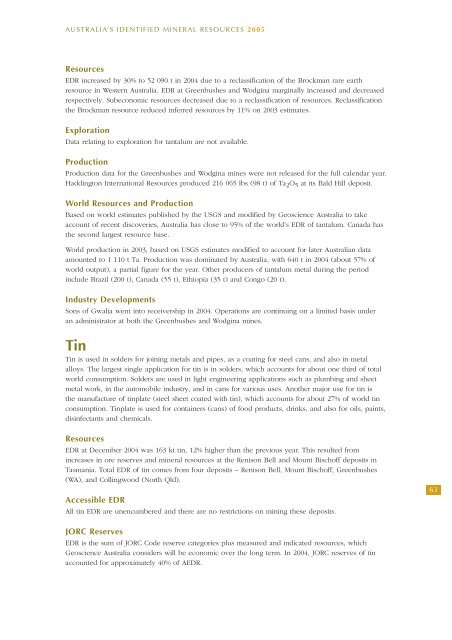australia's identified mineral resources 2005 - Geoscience Australia
australia's identified mineral resources 2005 - Geoscience Australia
australia's identified mineral resources 2005 - Geoscience Australia
Create successful ePaper yourself
Turn your PDF publications into a flip-book with our unique Google optimized e-Paper software.
AUSTRALIA’S IDENTIFIED MINERAL RESOURCES <strong>2005</strong><br />
Resources<br />
EDR increased by 30% to 52 090 t in 2004 due to a reclassification of the Brockman rare earth<br />
resource in Western <strong>Australia</strong>. EDR at Greenbushes and Wodgina marginally increased and decreased<br />
respectively. Subeconomic <strong>resources</strong> decreased due to a reclassification of <strong>resources</strong>. Reclassification<br />
the Brockman resource reduced inferred <strong>resources</strong> by 11% on 2003 estimates.<br />
Exploration<br />
Data relating to exploration for tantalum are not available.<br />
Production<br />
Production data for the Greenbushes and Wodgina mines were not released for the full calendar year.<br />
Haddington International Resources produced 216 065 lbs (98 t) of Ta 2 O 5 at its Bald Hill deposit.<br />
World Resources and Production<br />
Based on world estimates published by the USGS and modified by <strong>Geoscience</strong> <strong>Australia</strong> to take<br />
account of recent discoveries, <strong>Australia</strong> has close to 95% of the world’s EDR of tantalum. Canada has<br />
the second largest resource base.<br />
World production in 2003, based on USGS estimates modified to account for later <strong>Australia</strong>n data<br />
amounted to 1 110 t Ta. Production was dominated by <strong>Australia</strong>, with 640 t in 2004 (about 57% of<br />
world output), a partial figure for the year. Other producers of tantalum metal during the period<br />
include Brazil (200 t), Canada (55 t), Ethiopia (35 t) and Congo (20 t).<br />
Industry Developments<br />
Sons of Gwalia went into receivership in 2004. Operations are continuing on a limited basis under<br />
an administrator at both the Greenbushes and Wodgina mines.<br />
Tin<br />
Tin is used in solders for joining metals and pipes, as a coating for steel cans, and also in metal<br />
alloys. The largest single application for tin is in solders, which accounts for about one third of total<br />
world consumption. Solders are used in light engineering applications such as plumbing and sheet<br />
metal work, in the automobile industry, and in cans for various uses. Another major use for tin is<br />
the manufacture of tinplate (steel sheet coated with tin), which accounts for about 27% of world tin<br />
consumption. Tinplate is used for containers (cans) of food products, drinks, and also for oils, paints,<br />
disinfectants and chemicals.<br />
Resources<br />
EDR at December 2004 was 163 kt tin, 12% higher than the previous year. This resulted from<br />
increases in ore reserves and <strong>mineral</strong> <strong>resources</strong> at the Renison Bell and Mount Bischoff deposits in<br />
Tasmania. Total EDR of tin comes from four deposits – Renison Bell, Mount Bischoff, Greenbushes<br />
(WA), and Collingwood (North Qld).<br />
Accessible EDR<br />
All tin EDR are unencumbered and there are no restrictions on mining these deposits.<br />
63<br />
JORC Reserves<br />
EDR is the sum of JORC Code reserve categories plus measured and indicated <strong>resources</strong>, which<br />
<strong>Geoscience</strong> <strong>Australia</strong> considers will be economic over the long term. In 2004, JORC reserves of tin<br />
accounted for approximately 40% of AEDR.

















